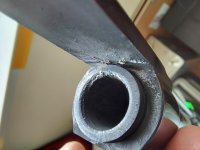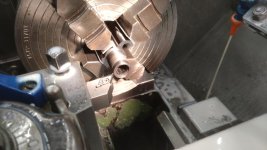BDC5109
Member
Hi y’all,
For all of you planning to replace/re-fit a barrel I want to share some fresh experience.
I am (well, my machinist is) in the process of refitting the existing barrel because of a worn out cone on my model 29 Classic Hunter 44mag from the late ’80.
To refit you just put it in a lath, turn the shoulder of the barrel 1 turn back and re-cut the cone. As simple as that, but..... (and get rid of the endshake first)
….with that action the barrel is perfect square/perpendicular.
Placed in the frame a difference between the barrel gap at the left and the right side appeared. The difference is 0,15mm. Which is the bandwidth of min to max barrel gap (factory margin min=0,10mm max=0,25mm). Appears on all chambers.
BTW: 0,15mm on 15mm barrel diameter is about 0,6° (so why the fuzz )
)
The barrel gaps per chamber has been equalized years ago when all was still fresh.
(probably all measured from 1 side of the frame)
Measured from the front of the frame to the front of the cylinder we see the same difference.
So, the message is: make sure the front of your frame is straight before you start re-cutting your barrel to the final fit or re-think what you want to do.
You can choose to take a file and do it the factory way, just file the end of the barrel by hand to the desired gap size knowing it is parallel but not square, or you square up your frame.
When you take a file, you move the problem to getting the cone within spec’s.
I think finding out if your frame is square can be done the easiest way by cleaning the end of your barrel by just a couple of tenths of mm. There should stay enough material to make the final cut.
After cleaning, replace the barrel, sort of hand tight, but tight enough to make it settle in the threading and touch the complete front of your frame without any play.
Then measure all the gaps, left and right, and draw a conclusion.
This is my 3rd barrel refit, the first 2 where on newer models, no red flags there.
The difference on them is below 0,05mm. Therefor the learning curve just started this weekend…..
Do not check the “square-ness” on the factory finish, they file the end of the barrel by hand.
At least they used to…..don’t know what they do in the MIM-era.
This is only about the swing from east to west, or 3 o’clock to 9 o’clock.
It can also be from 4 o’clock to 10 o’clock.
Have to speak to my machinist to discus how we’re going to measure that.
Besides this, the cylinder has a fair amount of play on the yoke.
I think this might explain why the lead (and copper!) built up is at the top.
I am going to replace the gasring with a custom made one that also functions as a bearing, to minimize play.
The hand is ok. It is a oversized handfitted Power Custom competition hand.
The cylinder locks in in time, the last thing I worry about shooting almost DA only
Used ammo to get to this point?
Well………one of my favorites was a lead cast 195 conical nose (Redding die) haunted by 26,7grains N110 pushing it over 500m/s.
In the time there were no chemical flash-minimizers used in powders resulting in large blue-white balloons
Best regards,
Hans Peter
For all of you planning to replace/re-fit a barrel I want to share some fresh experience.
I am (well, my machinist is) in the process of refitting the existing barrel because of a worn out cone on my model 29 Classic Hunter 44mag from the late ’80.
To refit you just put it in a lath, turn the shoulder of the barrel 1 turn back and re-cut the cone. As simple as that, but..... (and get rid of the endshake first)
….with that action the barrel is perfect square/perpendicular.
Placed in the frame a difference between the barrel gap at the left and the right side appeared. The difference is 0,15mm. Which is the bandwidth of min to max barrel gap (factory margin min=0,10mm max=0,25mm). Appears on all chambers.
BTW: 0,15mm on 15mm barrel diameter is about 0,6° (so why the fuzz
The barrel gaps per chamber has been equalized years ago when all was still fresh.
(probably all measured from 1 side of the frame)
Measured from the front of the frame to the front of the cylinder we see the same difference.
So, the message is: make sure the front of your frame is straight before you start re-cutting your barrel to the final fit or re-think what you want to do.
You can choose to take a file and do it the factory way, just file the end of the barrel by hand to the desired gap size knowing it is parallel but not square, or you square up your frame.
When you take a file, you move the problem to getting the cone within spec’s.
I think finding out if your frame is square can be done the easiest way by cleaning the end of your barrel by just a couple of tenths of mm. There should stay enough material to make the final cut.
After cleaning, replace the barrel, sort of hand tight, but tight enough to make it settle in the threading and touch the complete front of your frame without any play.
Then measure all the gaps, left and right, and draw a conclusion.
This is my 3rd barrel refit, the first 2 where on newer models, no red flags there.
The difference on them is below 0,05mm. Therefor the learning curve just started this weekend…..
Do not check the “square-ness” on the factory finish, they file the end of the barrel by hand.
At least they used to…..don’t know what they do in the MIM-era.
This is only about the swing from east to west, or 3 o’clock to 9 o’clock.
It can also be from 4 o’clock to 10 o’clock.
Have to speak to my machinist to discus how we’re going to measure that.
Besides this, the cylinder has a fair amount of play on the yoke.
I think this might explain why the lead (and copper!) built up is at the top.
I am going to replace the gasring with a custom made one that also functions as a bearing, to minimize play.
The hand is ok. It is a oversized handfitted Power Custom competition hand.
The cylinder locks in in time, the last thing I worry about shooting almost DA only
Used ammo to get to this point?
Well………one of my favorites was a lead cast 195 conical nose (Redding die) haunted by 26,7grains N110 pushing it over 500m/s.
In the time there were no chemical flash-minimizers used in powders resulting in large blue-white balloons
Best regards,
Hans Peter
Attachments
Last edited:


